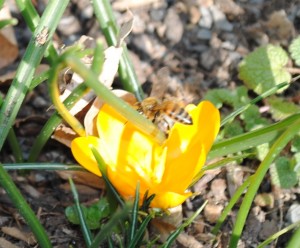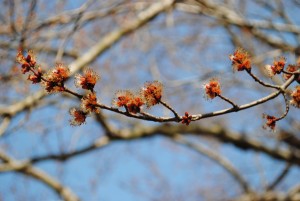
The Winter in Richmond, Virginia started out with a sledge hammer but appears to be going out like a tack hammer. It was really rough in December and most of January, but February has been uncharacteristically warm. Today, it appears to be heading into the upper 60’s and I really do not see much real cold in the foreseeable future (plus, we’ve already had nearly two weeks of weather like this!) We will no doubt see more cold weather, but March is just around the corner, which is the start of my favorite time with the bees!
As proof, I was finally rewarded with a few blooms over the past week! The crocuses started blooming around the 10th and I have had a few bees on them. But today, my early Maples started! Whoohoo! The bees have started to work the blooms a bit and I am hoping for a good brood build up. I expect to have a look at some of the hives in the apiary with the sugar syrup tomorrow. They have basically gone through 20 lbs of sugar (or what amounts to about 8 gallons of syrup) over the past two weeks and I am wondering what they are doing with it.

Now is really a good time to get some painting done. I have actually stayed ahead of this chore fairly well since last Fall, with a lot of painted deeps, mediums, shallows and nuc’s to show for it. But, I still have unpainted wooden-ware and now is as good a time as any to get that done, just in case. I am a firm believer in having twice as much as you think you will need and a little extra for any swarms or cut-outs that come along. One of the things that I am working on this weekend is equipment for two trapouts that I will be starting in March. I plan to use these bees to start several Nuc’s, if all goes well, so I want this stuff ready well in advance.
A trapout is mainly used to get the majority of the bees in a feral hive and eventually force the queen to leave the spot, due to no foragers returning. The beekeeper effectively takes most of the bees back to his yards and can then use them to start Nucs with queens from his best lines. The problem with trying this in early March is mainly that the bees will have only just started to grow their populations. So, you really only stand to get a fraction of the bees you might get if you started it in June (when the hive should be at max population.) But, that is all theory. There may be very good reasons to do it in March that I simply do not know since I have never tried it. Come April, I will have the results and it will be another lesson for the bee books!
